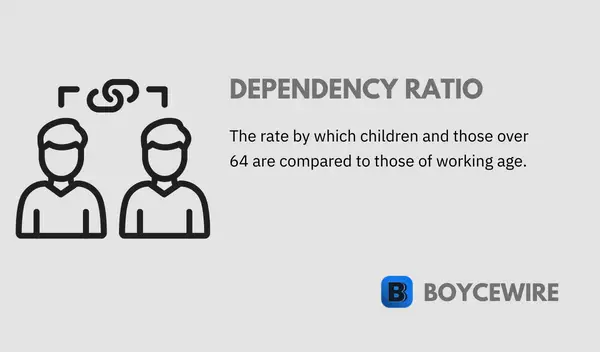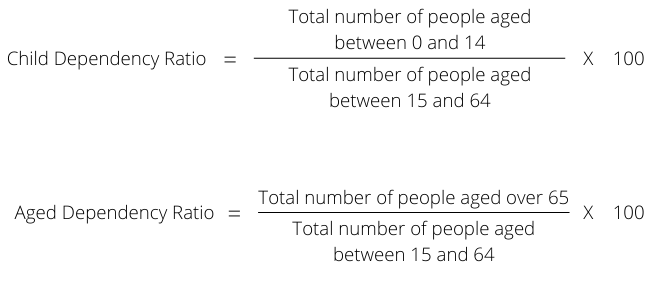Dependency Ratio: Definition, Formula, Effects & Example

What is the Dependency Ratio
The dependency ratio is the percentage of children and those over 64 years old, compared to people of working age. In other words, it is the ratio of young and old people who are not in work and are dependent on the taxpayer to pay for public services. Examples include public pensions, schooling, or other forms of social security.
It is called the dependency ratio because a proportion of the population is dependent on the other side to pay taxes to fund public goods and services. These range from policing to schooling and healthcare. Without the taxpayer contributing, those services wouldn’t be available to the dependents. The children and the elderly are therefore dependent on working age individuals to provide social services to them.
Key Points
- The Dependency Ratio calculates the number of young and old people and divides them by the total population including working adults.
- When the dependency ratio is high, it suggests that there is a large elderly/youthful population.
- The higher the dependency ratio, the more the working age population have to pay to sustain its dependents – unless services or social payments are reduced.
The dependency ratio includes all people, not just of working age. For instance, those between 16 and 64 are considered ‘of working age’, so they are not considered as dependents. By comparing the demographic breakdown between dependents and those of working ages, it helps economists, governments, banks, and other industries determine the trajectory a nation is on.
A nation with a high dependency ratio would suggest that it is highly reliant on the working-age population to pay for services for the ‘dependents’. This means for one elderly person, there may only be two people to fund their pension and other public services they need. However, it may also suggest that the nation has had a baby boom. In this case, fiscal policy may not need to alter as those will grow up and become tax payers. It is only when the nation is elderly does it become an issue on how to finance those individuals in old age through pensions and healthcare.
This is important, particularly for policymakers. If the dependency ratio is increasing, it means there are going to be fewer people paying for an even bigger expenditure. This is particularly a problem for nations with generous public pensions. As the elderly start to retire, it puts more pressure on the working population and the treasury to fund it.
Dependency Ratio Formula
The dependency ratio can be calculated by adding the child dependency ratio, with the aged dependency ratio. So those under 16, added to those over 64.
These can be calculated using the formula below:

These are then added together to get the total dependency ratio.
The formula for the dependency ratio is – (the number of people aged between 0 and 15 + the number of people aged 65 and above) divide by the total population between 16 and 64, times by 100.
Dependency Ratio Example
If we take Japan as an example of the dependency ratio – it had a population of 126.6 million as of 2018. In the same year, it had 75.6 million people aged between 15 and 64, with a further 16 million aged under 15. The child dependency ratio is then calculated by dividing those under 15 (16 million), by those of working age (75.6 million).
Therefore, the child dependency ratio for Japan = 16 million / 75.6 million x 100 = 21.16.
We must then calculate the aged dependency ratio. So in Japan, the population over 65 is 35 million. Therefore, the aged dependency ratio for Japan = 35 million / 75.6 million x 100 = 46.3.
Note: Aged dependency = those over 65. Child depency = those under 15. Dependency Ratio = (Aged dependcy + Child Dependency) / Total Population
In turn, the total dependency ratio equals 21.16 (child dependency ratio) + 46.3 (aged dependency ratio) = 67.46.
In English, this means that for every 2 dependents, there are roughly 3 working-age people supporting them through the tax system.
This contrasts dramatically to the 1990s where Japan’s ratio was as low as 43. That translates to roughly 2 dependents for 5 working-age people. So over the course of the last 30 years, the dependent population of Japan is relying on 2 fewer workers to support the system than before.
Effects of a High Dependency Ratio
A high dependency ratio means that the ‘dependents’ in society are more reliant on a smaller number of working-aged people. For instance, there may be one dependent in society and the dependency ratio may be 10, which would suggest that there are 10 people providing for that dependent. That means the taxes working-age people are paying are going towards their pensions, their education, or perhaps their housing benefits.
There are a number of effects a high dependency ratio can have. Some examples include:
1. Higher Cost Per Person
So as a dependency ratio increases, it means there are fewer people to pay for these. That’s putting a higher pressure and a higher cost on each individual to provide for the dependents in society.
If a pensioner gets $500 a week, that may be split out across 10 people at $50 per head. However, when the ratio increases, it may mean that the same $500 has to be split out between 2 people, meaning $250 per head.
2. Lower Social Security
A higher dependency ratio means that the working-age people have to pay more. However, higher taxes are never popular, which can result in a reduction in expenditure instead.
In fear of a political backlash, it may be more politically feasible to reduce existing expenditures. That may mean lower public pensions, less spent on education, or other social security benefits.
3. Budget Deficit
Increasing taxes is politically unpopular, but so too is reducing benefit payments. In turn, the incumbent government may look to do neither in order to retain political favour. The last option available to them would be to increase government debt and borrow the money instead.
This option can prove to be catastrophic in the long run, especially if the trend continues to worsen. An increasing debt burden and deficit may eventually lead the nation to default on its debts; making future borrowing almost impossible.
Solutions to Higher Dependency Ratios
High dependency ratios make for a serious problem. Governments have to increase taxes, reduce benefits, or increase their debt. None of which are favourable. In turn, it is necessary to look for solutions. Such solutions to a higher dependency ratio include:
- Increase Retirement Age
- Let Inflation Erode Costs
- Encourage Youth Immigration
- Stimulate Economic Growth
1. Increase Retirement Age
One of the most favorable solutions is to increase the retirement age. That way, the government has less to pay in public pensions to the elderly. At the same time, we are living longer than ever, so it also makes sense from an actuarial point of view.
With that said, a phasing option has been suggested, whereby elderly people may be able to gradually ‘phase out’ of the workforce. So they would gradually do fewer and fewer days as they reach retirement.
The reason is twofold. Firstly, staying in work is said to provide both psychological, but also physical health benefits. The feeling of accomplishment and worth, as well as the social aspect, are important factors.
By staying in work longer, it reduces the burden placed upon the rest of the working-age population, thereby reducing the financial impact.
2. Let Inflation Erode Costs
Reducing benefits is an unfavorable political option. Those who rely on social security may see their benefits fall from $300 a week to $250. The drop is visible and noticeable.
What many governments have done is to let inflation erode these costs. So as inflation increases, the benefits paid remain the same or at least increase at a slower rate than inflation. This way, the real cost actually decreases due to the effects of inflation.
3. Encourage Youth Immigration
Many nations are starting to encourage young immigrants to come and help address the dependency ratio. This solves two problems. First of all, it solves the shortage in labour in industries such as agriculture, hospitality, and caring. Second of all, it brings in someone who can pay taxes in order to look after the dependents in the nation.
This isn’t without its problems however, with domestic citizens becoming disgruntled by people who do not share similar cultures or beliefs. In turn, civil unrest may ensue in the levels are left unchecked.
So whilst youth immigration is a potential solution, it may not be the most viable one; at least not by itself.
4. Stimulate Economic Growth
Another potential solution to the growing costs is economic growth. As a smaller number of people are having to sustain a growing number of dependents, the main solution is to become more efficient. In economic speak, that means economic growth through productivity gains.
If the working-age population is more productive, it means they are producing more in the same number of hours or days. In turn, the additional output they produce may be used to help sustain the dependents among the population.
In terms of how this can be achieved, there are a number of ways. Some would argue that deregulation would have a positive impact here, whilst others would argue that a Keynesian approach of government spending would be best.
FAQs
The dependency ratio can be calculated by adding the child dependency ratio, with the aged dependency ratio. So the ratio of those under 15, added to the ratio of those over 64.
This can be calculated using the formula:
The dependency ratio is the percentage of children and those over 64 years old, compared to the people who are of working age. In other words, young and old people who are not in work, are dependent on the taxpayer to pay for public services. That includes public pensions, schooling, or other forms of social security.
There are many affects of a high ratio. Some of them include:
1. Higher taxes to the working population
2. Lower public spending
3. Increased government borrowing
About Paul
Paul Boyce is an economics editor with over 10 years experience in the industry. Currently working as a consultant within the financial services sector, Paul is the CEO and chief editor of BoyceWire. He has written publications for FEE, the Mises Institute, and many others.

Further Reading
 Recession: Definition, Causes, Effects & Solutions - In economics, a recession is defined as a decline in economic growth.
Recession: Definition, Causes, Effects & Solutions - In economics, a recession is defined as a decline in economic growth.  Perpetuity: Definition, Formula, Types & Examples - In finance, perpetuity refers to the ongoing payment of a bond or security with no end date. Payments are made…
Perpetuity: Definition, Formula, Types & Examples - In finance, perpetuity refers to the ongoing payment of a bond or security with no end date. Payments are made…  Balance Sheet: Definition, Format & Example - The balance sheet is a key financial statement that public and private companies report on. It highlights a firm's assets,…
Balance Sheet: Definition, Format & Example - The balance sheet is a key financial statement that public and private companies report on. It highlights a firm's assets,… 
